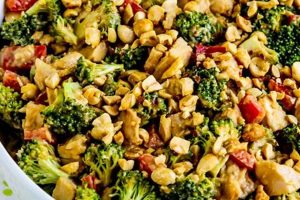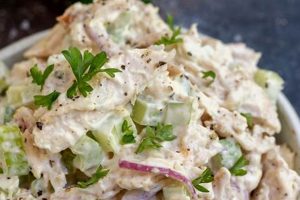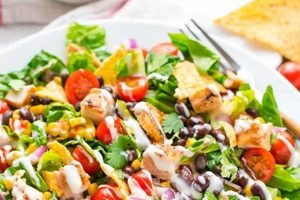Combinations of cooked chicken, mayonnaise, and various other ingredients create a versatile dish enjoyed as a sandwich filling, salad topping, or standalone meal. Classic variations often include celery, onion, and seasonings like mustard and pepper. More elaborate versions might incorporate grapes, nuts, dried fruits, or apples, offering a wide range of flavor profiles.
The adaptability of this dish contributes to its widespread appeal. It can be served for casual lunches, elegant picnics, or even as part of a larger buffet. Its relatively quick preparation time and the ability to use leftover chicken make it a practical and economical choice. Furthermore, the dish allows for significant nutritional customization depending on the chosen ingredients, offering options for healthier variations. The history of the dish can be traced back to the mid-19th century, gaining popularity as refrigeration became more commonplace.
This exploration will delve into various facets of creating delectable chicken salads. Topics covered will include classic and innovative ingredient combinations, tips for achieving optimal texture and flavor, nutritional considerations, and suggestions for serving and presentation.
Tips for Exceptional Chicken Salad
Achieving a superior chicken salad involves attention to detail in ingredient selection, preparation techniques, and flavor balancing.
Tip 1: Chicken Selection: Opt for high-quality cooked chicken. Rotisserie chicken offers excellent flavor and moistness, while poached or baked chicken breasts provide a leaner option. Canned chicken can be used, but ensure it is drained thoroughly.
Tip 2: Mayonnaise Matters: The quality of mayonnaise significantly impacts the overall flavor. Experiment with different brands and types, such as olive oil or avocado oil-based mayonnaise, to find a preferred taste and texture. Consider using a combination of mayonnaise and plain Greek yogurt for a lighter, tangier option.
Tip 3: Chop Consistency: Ensure ingredients are chopped to a consistent size. This not only enhances the aesthetic appeal but also ensures even distribution of flavors and textures throughout the salad.
Tip 4: Seasoning Strategy: Don’t limit seasoning to salt and pepper. Fresh herbs, such as dill, parsley, or chives, can elevate the flavor profile. Experiment with spices like paprika, curry powder, or garlic powder for unique variations.
Tip 5: Balancing Flavors: Achieve a balance between savory and acidic elements. A touch of lemon juice or apple cider vinegar can brighten the flavors and prevent the salad from becoming overly rich. A small amount of Dijon mustard adds complexity.
Tip 6: Chill Time: Allowing the chicken salad to chill in the refrigerator for at least 30 minutes allows the flavors to meld and develop. This step is crucial for optimal enjoyment.
Tip 7: Serving Suggestions: Chicken salad offers versatility in presentation. Serve it on croissants, crackers, bread, lettuce cups, or as a filling for tomatoes or avocados. Garnish with fresh herbs or a sprinkle of paprika for an added touch.
By following these tips, one can consistently create chicken salad that is both flavorful and satisfying. Attention to these details elevates the dish from simple to extraordinary.
This exploration concludes with a summary of key takeaways and considerations for adapting these techniques to individual preferences.
1. Classic
Classic chicken salad recipes represent a foundational understanding of this versatile dish. They provide a benchmark against which variations are developed and offer a familiar comfort rooted in tradition. Exploring the core components of classic chicken salad reveals the interplay of simplicity, flavor, and texture that contribute to its enduring popularity.
- Core Ingredients:
Classic chicken salad recipes typically feature a concise list of ingredients. Cooked chicken, mayonnaise, celery, and onion form the foundation, creating a harmonious blend of savory and subtly sweet flavors. These simple components are readily available, contributing to the widespread accessibility of the dish. Minor additions like mustard, salt, and pepper enhance the overall taste profile.
- Texture and Consistency:
The texture of classic chicken salad is characterized by a creamy base provided by the mayonnaise, punctuated by the crispness of celery and the slight bite of onion. The chicken is typically shredded or diced, providing a pleasant contrast to the smoother elements. This textural balance is a hallmark of traditional preparations.
- Simplicity and Versatility:
The simplicity of classic chicken salad is a key factor in its adaptability. It serves as a blank canvas for culinary creativity, allowing for effortless customization through the addition of herbs, spices, or other complementary ingredients. This versatility extends to its serving options, ranging from sandwiches and wraps to salads and appetizers.
- Enduring Appeal:
The enduring appeal of classic chicken salad lies in its familiarity and consistent delivery of satisfying flavors. It represents a culinary constant, offering a comforting and predictable taste profile that transcends generations. Its straightforward preparation and readily available ingredients contribute to its continued popularity.
The examination of these core facets of classic chicken salad underscores its significance within the broader context of popular chicken salad recipes. It serves as a starting point for culinary exploration, offering a framework upon which innovative variations can be built while maintaining a connection to the dish’s fundamental elements.
2. Healthy
Health-conscious adaptations of chicken salad recipes have gained significant traction, reflecting a broader societal emphasis on nutritious eating. This trend drives innovation in ingredient selection and preparation methods, resulting in variations that prioritize both flavor and well-being. The connection between “healthy” and “popular chicken salad recipes” lies in the ability to modify traditional recipes to reduce fat and calories without sacrificing taste or satisfaction. This is achieved through strategic substitutions and mindful portion control.
A primary example involves replacing traditional mayonnaise with Greek yogurt or avocado. Greek yogurt provides a creamy texture similar to mayonnaise but with significantly less fat and added protein. Avocado offers healthy fats and a rich, satisfying mouthfeel. Further reductions in caloric content can be achieved by incorporating leaner protein sources, such as poached chicken breast, and increasing the proportion of vegetables like celery, cucumber, and bell peppers. These additions contribute fiber and essential nutrients while enhancing flavor and texture. The use of whole-grain bread or lettuce wraps instead of refined white bread also contributes to the nutritional value.
The practical significance of understanding this connection lies in the empowerment it provides to individuals seeking healthier meal options without compromising enjoyment. By embracing these adaptable recipes, consumers can integrate a flavorful and nutritious dish into their diets. This understanding further fosters culinary creativity, encouraging experimentation with diverse ingredients and flavor profiles within a health-conscious framework. Challenges may include achieving the desired creamy texture when deviating significantly from traditional mayonnaise-based recipes. However, continued experimentation with alternative ingredients and techniques allows for the development of satisfying and healthful variations that cater to a range of dietary preferences.
3. Creative
Creative variations within popular chicken salad recipes demonstrate the dish’s adaptability and potential to transcend traditional boundaries. Exploration of this facet reveals how innovative ingredient combinations and flavor profiles contribute to the ongoing evolution of this culinary staple. Understanding the creative aspects allows for a deeper appreciation of the dish’s versatility and its capacity to satisfy diverse palates.
- Global Influences:
Culinary traditions from around the world offer inspiration for creative chicken salad adaptations. Incorporating ingredients like curry powder, mango chutney, or toasted sesame seeds introduces unique flavor dimensions. A Thai-inspired version might include peanuts, cilantro, and lime juice, while a Mediterranean approach could feature olives, feta cheese, and oregano. These global influences broaden the appeal of chicken salad, catering to adventurous tastes and expanding culinary horizons.
- Textural Contrasts:
Creative chicken salad recipes often emphasize textural contrasts to elevate the sensory experience. Adding ingredients like chopped nuts, dried cranberries, or crispy fried onions introduces layers of crunch and chewiness. These textural variations complement the creamy base of the salad, creating a more dynamic and engaging mouthfeel. Such innovations enhance the overall enjoyment of the dish.
- Fruit and Herb Combinations:
The incorporation of fruits and herbs provides opportunities for creative flavor pairings. Apples, grapes, and dried apricots offer sweetness and subtle tartness, while fresh herbs like dill, tarragon, or chives contribute aromatic complexity. These additions can transform a traditional chicken salad into a vibrant and refreshing dish, showcasing the interplay of sweet, savory, and herbaceous notes.
- Presentation and Serving Styles:
Creative presentation elevates chicken salad beyond a simple scoop. Serving the salad in hollowed-out avocados, bell peppers, or tomatoes creates visually appealing and flavorful vessels. Using endive leaves or cucumber rounds as bases adds an element of freshness and elegance. These innovative serving styles enhance the dining experience, transforming a casual dish into a more sophisticated presentation.
These creative facets demonstrate how popular chicken salad recipes continue to evolve, adapting to changing tastes and culinary trends. The exploration of these elements reveals the inherent flexibility of the dish, allowing for endless experimentation and personalization. By embracing creative approaches, individuals can discover new flavor combinations and serving styles that elevate chicken salad from a familiar staple to a culinary adventure.
4. Quick
The demand for quick meal solutions directly influences the popularity of certain chicken salad recipes. Time constraints and busy lifestyles necessitate convenient preparation methods without sacrificing flavor or satisfaction. This exploration examines the connection between speed and popularity, highlighting the elements that contribute to the appeal of quick chicken salad recipes.
- Pre-Cooked Chicken:
Utilizing pre-cooked chicken, such as rotisserie or canned chicken, significantly reduces preparation time. This readily available ingredient eliminates the need for cooking and shredding or dicing raw chicken, streamlining the overall process. The convenience factor contributes significantly to the popularity of recipes featuring pre-cooked chicken, allowing for a quick and flavorful meal.
- Simple Ingredient Lists:
Quick chicken salad recipes often feature streamlined ingredient lists, focusing on readily available pantry staples. Minimizing the number of components simplifies the shopping and preparation process, appealing to those seeking efficient meal solutions. This streamlined approach does not necessarily equate to a lack of flavor; strategic combinations of a few key ingredients can still deliver a satisfying and flavorful outcome.
- Minimal Chopping and Mixing:
Recipes that minimize chopping and mixing further expedite the preparation process. Ingredients like pre-chopped celery or onion contribute to this efficiency. Utilizing a food processor can further reduce preparation time by quickly chopping and combining ingredients. This streamlined approach caters to the demand for quick and effortless meal preparation.
- Adaptability to Meal Prepping:
Quick chicken salad recipes often lend themselves well to meal prepping, further enhancing their convenience factor. Preparing a larger batch in advance allows for multiple quick meals throughout the week. This adaptability aligns with the growing trend of meal prepping, appealing to individuals seeking efficient and organized meal planning solutions.
The convergence of these elementspre-cooked ingredients, simple recipes, minimal preparation, and adaptability to meal preppingcontributes to the popularity of quick chicken salad recipes. These factors collectively address the need for efficient and convenient meal solutions without compromising on flavor or satisfaction. This understanding highlights the ongoing adaptation of culinary practices to meet the demands of modern lifestyles.
5. Adaptable
Adaptability stands as a cornerstone of the enduring popularity of chicken salad recipes. This inherent flexibility allows the dish to cater to a wide spectrum of dietary needs, preferences, and available ingredients. The cause-and-effect relationship between adaptability and popularity is evident: as recipes adapt, they resonate with a broader audience, increasing their overall appeal. This adaptability stems from the dish’s simple core structurecooked chicken and a binding agentwhich provides a blank canvas for culinary exploration.
The significance of “adaptable” as a component of popular chicken salad recipes is multifaceted. Consider dietary restrictions: vegetarian versions substitute chicken with chickpeas or tofu, while gluten-free options utilize gluten-free bread or lettuce wraps. Ingredient availability also plays a role. Recipes can be modified based on what is readily available, substituting grapes for apples, walnuts for pecans, or incorporating seasonal vegetables. This flexibility ensures the dish remains accessible and appealing regardless of geographical location or seasonal limitations. Real-life examples include using leftover Thanksgiving turkey in place of chicken, creating a festive post-holiday variation, or adding curry powder and raisins for an Indian-inspired twist. Adaptability also extends to presentation, with the salad served in sandwiches, wraps, scooped onto crackers, or incorporated into lettuce cups.
The practical significance of understanding this connection lies in the potential for personalized culinary experiences. Recipes become less prescriptive and more suggestive, empowering individuals to tailor dishes to specific tastes and circumstances. This fosters creativity in the kitchen and transforms chicken salad from a static recipe into a dynamic and evolving culinary concept. While the potential for variations is vast, maintaining a balance of flavors and textures remains crucial. Overly ambitious adaptations may compromise the fundamental essence of the dish. However, thoughtful experimentation, guided by an understanding of core flavor profiles and textural elements, strengthens the connection between “adaptable” and “popular chicken salad recipes,” ensuring its continued relevance and appeal.
Frequently Asked Questions
This section addresses common inquiries regarding the preparation and enjoyment of chicken salad, offering practical guidance and clarifying potential points of confusion. These responses aim to provide a comprehensive understanding of various aspects related to this versatile dish.
Question 1: What is the best type of chicken to use for chicken salad?
While various cooked chicken options are suitable, rotisserie chicken offers excellent flavor and moistness. Poached or baked chicken breasts provide a leaner alternative. Canned chicken is acceptable, but ensure thorough draining.
Question 2: How can one achieve a creamier texture without excessive mayonnaise?
Incorporating Greek yogurt or mashed avocado can enhance creaminess while reducing overall fat content. A small amount of sour cream or crme frache can also contribute to a richer texture.
Question 3: How long can chicken salad be stored in the refrigerator?
Properly stored in an airtight container, chicken salad typically remains safe to consume for three to five days in the refrigerator. Always assess the quality before consumption, discarding any salad with an off odor or appearance.
Question 4: Can chicken salad be frozen?
While freezing is possible, the texture of the mayonnaise-based dressing may be negatively affected upon thawing. Freezing is generally not recommended for optimal quality.
Question 5: How can one prevent the chicken salad from becoming watery?
Ensure all ingredients, particularly vegetables, are adequately drained before incorporating them into the salad. Over-mixing can also contribute to excess moisture. A gentle folding technique is recommended.
Question 6: What are some creative serving suggestions beyond sandwiches?
Chicken salad offers versatility in presentation. Consider serving it in lettuce cups, avocado halves, or tomato shells. It can also be used as a filling for croissants, wraps, or baked potatoes.
These responses provide practical guidance for preparing and enjoying chicken salad. Applying these insights enhances the overall culinary experience and addresses potential challenges.
This concludes the frequently asked questions section. The following section will offer a collection of popular chicken salad recipes, providing practical examples of the principles discussed throughout this exploration.
Popular Chicken Salad Recipes
Exploration of popular chicken salad recipes reveals a dish characterized by versatility and adaptability. From classic preparations emphasizing simplicity to innovative variations incorporating diverse ingredients and global influences, the core components of cooked chicken and a binding agent provide a foundation for extensive culinary creativity. Examination of health-conscious adaptations, time-saving techniques, and personalized ingredient selections underscores the dish’s capacity to cater to a broad spectrum of dietary needs and lifestyle preferences. Understanding the interplay of these elementsflavor, texture, convenience, and adaptabilityprovides a comprehensive framework for appreciating the enduring appeal of this culinary staple.
The ongoing evolution of popular chicken salad recipes reflects a dynamic interplay between tradition and innovation. As culinary preferences continue to evolve and dietary awareness expands, the inherent adaptability of this dish ensures its continued relevance within the culinary landscape. Further exploration and experimentation promise to uncover new flavor combinations, innovative presentation styles, and health-conscious adaptations, solidifying chicken salad’s position as a timeless and versatile culinary creation.






